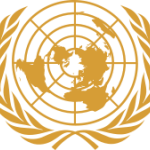- المجال: NGO
- Number of terms: 31364
- Number of blossaries: 0
- Company Profile:
The United Nations Organization (UNO), or simply United Nations (UN), is an international organization whose stated aims are facilitating cooperation in international law, international security, economic development, social progress, human rights, and the achieving of world peace.
Cuprates (from Latin cuprum meaning copper) are chemical compounds containing copper anion. Cuprates have been known for centuries and are widely used in inorganic and organic chemistry. However, interest in them has significantly increased since 1986 after the discovery of high-temperature superconductivity in a lanthanum barium copper oxide by Georg Bednorz and Karl Müller.[1] More than 100,000 scientific papers were published on superconductivity in cuprates between 1986 and 2001,[2] and Bednorz and Müller were awarded the Nobel Prize in Physics only a year after their discovery.[3] From 1986 to 2008, almost all known high temperature superconductors were cuprate superconductors and the highest confirmed, ambient-pressure, superconducting transition temperature (Tc) was 135 K achieved in a layered cuprate HgBa2Ca2Cu3Ox in 1993.[4] [5]
Industry:Inorganic chemicals
Cuprati (dal latino cuprum rame significato) sono composti chimici contenenti rame anione. Cuprati sono conosciute da secoli e sono ampiamente utilizzati in chimica organica ed inorganica. Tuttavia, l'interesse in loro ha aumentato significativamente dal 1986 dopo la scoperta della superconduttività ad alta temperatura in un ossido di lantanio bario rame di Georg Bednorz e Karl Müller.[1] Più di 100.000 articoli scientifici sono stati pubblicati su superconduttività in cuprati tra il 1986 e il 2001, [2] e Bednorz e Müller ricevettero il premio Nobel per la fisica in solo un anno dopo la loro scoperta.[3] Dal 1986 al 2008, quasi tutti i superconduttori noti ad alta temperatura sono stati ad superconduttori e il più alto confermato, pressione ambiente, temperatura di transizione superconduttiva (Tc) era K 135 raggiunto in uno stratificato ad HgBa2Ca2Cu3Ox nel 1993.[4] [5]
Industry:Inorganic chemicals
Cuprates (od łacińskiego łacińskacuprum znaczenie miedzi) są związki chemiczne zawierające miedź anionowymienną. Cuprates znane są od wieków i są szeroko stosowane w chemii nieorganicznej i organicznej. Jednak zainteresowanie nimi ma znacznie wzrosła od 1986 roku po odkryciu wysokiej temperaturze nadprzewodnictwa w lantanu Tlenek baru miedzi przez Georg Bednorz i Karl Müller.[1] Ponad 100.000 prace naukowe zostały opublikowane na nadprzewodnictwa w cuprates w latach 1986-2001, [2] i Bednorz i Müller przyznano nagrodę Nobla w fizyki dopiero w rok po ich odkryciu.[3] Od 1986 r. do 2008 r., prawie wszystkie znane wysokotemperaturowe nadprzewodniki były miedzian nadprzewodniki i najwyższy potwierdził, presja otoczenia, temperatura zeszklenia nadprzewodzących (Tc) było 135 K osiągnięte w warstwowe miedzian HgBa2Ca2Cu3Ox w 1993 roku.[4] [5]
Industry:Inorganic chemicals
Купратов (от латинского cuprum смысл медь) являются химические соединения, содержащие медь анион. Купратов были известны на протяжении многих веков и широко используются в неорганической и органической химии. Однако интерес к ним значительно возросло с 1986 года после открытия сверхпроводимости при высоких температурах в бария меди оксид лантана, Георг Bednorz и Карл Мюллер.[1] Более чем 100 000 научных статей были опубликованы на сверхпроводимости в купратов между 1986 и 2001 года, [2] и Bednorz и Мюллер были удостоены Нобелевской премии в физике только через год после их открытия.[3] С 1986 по 2008, почти все известные высокотемпературных сверхпроводников были купрат сверхпроводников и высокие подтвердил, атмосферного давления, Температура сверхпроводящего перехода (ТС) было 135 K, достигнутые в слоистых купрат HgBa2Ca2Cu3Ox в 1993 году.[4] [5]
Industry:Inorganic chemicals
Les cuprates (du Latin cuprum cuivre de sens) sont des composés chimiques contenant l'anion cuivre. Les cuprates sont connus depuis des siècles et sont largement utilisés en chimie organique et inorganique. Cependant, intérêt pour eux a considérablement augmenté depuis 1986, après la découverte de la supraconductivité à haute température dans un oxyde de cuivre de baryum de lanthane par Georg Bednorz et de Müller de Karl.[1] Plus de 100 000 articles scientifiques ont été publiés sur la supraconductivité dans les cuprates entre 1986 et 2001 [2] et Bednorz et Müller ont obtenu le prix Nobel de physique en seulement un an après leur découverte.[3] De 1986 à 2008, presque tous les supraconducteurs à température élevée connus étaient cuprate supraconducteurs et les plus élevés ont confirmé, pression ambiante, température de transition supraconductrice (Tc) a été 135 K atteint dans un cuprate en couches HgBa2Ca2Cu3Ox en 1993.[4] [5]
Industry:Inorganic chemicals
Les cuprates (du Latin cuprum cuivre de sens) sont des composés chimiques contenant l'anion cuivre. Les cuprates sont connus depuis des siècles et sont largement utilisés en chimie organique et inorganique. Cependant, intérêt pour eux a considérablement augmenté depuis 1986, après la découverte de la supraconductivité à haute température dans un oxyde de cuivre de baryum de lanthane par Georg Bednorz et de Müller de Karl.[1] plus de 100 000 articles scientifiques ont été publiés sur la supraconductivité dans les cuprates entre 1986 et 2001 [2] et Bednorz et Müller ont obtenu le prix Nobel de physique en seulement un an après leur découverte.[3] de 1986 à 2008, presque tous les supraconducteurs à température élevée connus étaient cuprate supraconducteurs et les plus élevés ont confirmé, pression ambiante, température de transition supraconductrice (Tc) a été 135 K atteint dans un cuprate en couches HgBa2Ca2Cu3Ox en 1993.[4] [5]
Industry:Inorganic chemicals
銅酸化物は、(ラテン語cuprumの意味の銅から)銅の陰イオンを含む化合物である。銅酸化物は、何世紀にもわたって知られており、広く無機と有機化学で使用されています。しかし、彼らの関心は大幅にゲオルクBednorzとカールミュラーのランタンバリウム銅酸化物における高温超伝導の発見の後、1986年以降増加している。[1] 10万人以上の科学論文は1986年と2001年の間に銅酸化物超伝導体で出版された、 [2]とBednorzとMüller氏は、今年ノーベル物理学賞を受賞した彼らの発見の後。[3] 1986年から2008年まで、ほとんどすべての既知の高温超伝導体は転移温度超伝導、銅酸化物超伝導体と最高確認し、周囲のプレッシャーだった(Tc)は1993年に層状銅酸化物のHgBa2Ca2Cu3Oxで135 Kを達成した。[4] [5]
Industry:Inorganic chemicals
Diplomatic process of brokering an end to a conflict, principally through mediation and negotiation, as foreseen under Chapter VI of the UN Charter; military activities contributing to peacemaking include military-to-military contacts, security assistance, shows of force and preventive deployments.
Industry:Military
New and tentative concept applying to the multidimensional operations which, while originally mandated under chapter VI, are forced by realities in the field to turn into a chapter VII operations, as when humanitarian convoys need to be defended by force of arms, or exclusion zone enforced by air strikes.
Industry:Military
Area between the forward line of the parties, into which they have agreed not to deploy military forces and which may be placed under the control of a PKO.
Industry:Military
